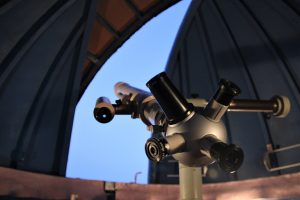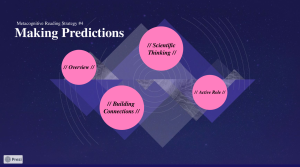20 Making Predictions
Learning Objectives
-
Practice strategies for making predictions within a narrative to improve reading comprehension.
-
Appropriately paraphrase and summarize texts.
Chapter & Discussion
This chapter includes a presentation that can be navigated in a classroom setting or independently. You can access the presentation via the link below.
Strategy Four: Making Predictions
Work through the different sections of the chapter and discuss ideas and topics as they arise. If you’re working independently, take notes instead. Notes and active discussion will be helpful in navigating this week’s assignments.
Overview
One important metacognitive reading strategy is to make predictions about what will happen next in a reading. This will help you to keep track of the relevant information and help you make use of it. Predictions help make connections between new knowledge and what you already know.
One interesting thing about this strategy is that it doesn’t matter if your prediction is right or wrong. The fact that you made a prediction helps you to activate your scientific thinking, improves your memory, and helps you constantly “keep score” when you read. All of this greatly improves comprehension.
Building Connections
Making predictions activates our prior knowledge before reading, which helps us better understand the new information we will encounter in the text. Activating relevant prior knowledge provides a foundation for making connections to new information.
Making predictions prompts readers to draw on their experiences related to the topic at hand. This activation of prior knowledge serves as a foundation for understanding new information. By connecting what they already know with the text, readers are better equipped to comprehend and make sense of the material.

Scientific Thinking
The process of making predictions encourages us to think actively during reading, rather than just passively receiving the information. We naturally make predictions as we read. By stopping regularly to predict, we are engaged in active reading rather than passive reception.
The process is very similar to when we use the scientific method. It requires gathering evidence and identifying patterns to make reasonable predictions about future events. It involves logical thinking to take what is known and make an inference about what is likely to occur. The process parallels forming hypotheses in science based on observations. And, there is an emphasis on testing predictions to see if they are correct, similar to scientists testing hypotheses through investigation.

Taking an Active Role
Checking whether predictions come true motivates students to read further and monitor their comprehension. The anticipation of checking predictions motivates students to continue reading.
Prediction activities, especially when combined with explicit verification during reading, improve students’ overall comprehension and memory for what they read.
Making predictions also helps focus students’ attention on the key content and structure of the text. When readers make predictions, they read with a specific purpose in mind: to confirm or adjust their predictions based on the unfolding information. This purposeful reading keeps them actively engaged, focused, and motivated to extract relevant details from the text. It transforms reading from a passive activity into an interactive and goal-oriented process.
Activity: Taking an Active Role
A study by Mary Shoop in 1986 called “InQuest: A Listening and Reading Comprehension Strategy” found that students improved comprehension by engaging in an activity where they took on the role of investigative journalists who attempted to use the information at hand to predict future outcomes. This comprehension improved whether or not the students were correct in their hypotheses.
Choose one of the short films from our Films to Teach Story Elements playlist.
After one minute, answer the following questions:
What do you think will happen next?
What will happen overall?
What do you think are the director’s goals for this film?
Then, watch the rest. For each prediction, note whether you were right or wrong, AND what the answer turned out to be.
Assigned Reading
Here are this week’s readings. Additionally, please read for your own personal enjoyment for 1/2 hour each day. This will be called your “Reading Zone” reading and it will coincide with many upcoming activities.
Short Films to Teach Story Elements Playlist
Problem Set: Practice Your Skills!
Click here to complete a ten-question problem set on concepts in this chapter.
Completing problem sets like this can be an important element of independent study towards completing your HSE. I write these to resemble the style of questions you’ll find on the Reading and Language Arts GED.
Assignment: Making Predictions (250 Words)
Find a film from the Short Films to Teach Story Elements Playlist. Start your film and a one-minute timer at the same time. Once one minute is up, pause your film. Write a prediction for what will happen next. Explain your reasoning. This should be about 150 words.
Resume your film. How did your prediction pan out? Was it true, false, or partially true? How did this process get you thinking about the elements of a story? What are your thoughts on this story? This should be about 150 words.
Assignment: Reading Zone Response (250 Words)
For Reading Zone, you must find a novel that is interesting to you and enjoyable to read. If you need help finding a Reading Zone book, please ask. Please read your Reading Zone book for a half-hour each day. On class days, there will be time in class dedicated to reading.
Create a two-paragraph response to the reading you did this week. The first paragraph should summarize what you read this week. The second paragraph should address the following prompt:
Make a prediction of something that will happen soon in your story and another prediction of something that will happen later. Why do you think so? How might your prediction tie into the author’s overall goals?
Attributions
Duke, N. K., & Pearson, P. D. (2002). Effective practices for developing reading comprehension. In A. E. Farstrup & S. J. Samuels (Eds.), What research has to say about reading instruction (3rd ed) (pp. 205-242). Newark, DE: International Reading Association. Reprinted in Journal of Education, 189, 107-122.
Mills, Kathy A. (2008) The Seven Habits of Highly Effective Readers. In Proceedings Stories, Places, Spaces: Literacy and Identity, National conference by the Australian Literacy Educators’ Association (ALEA) and Australian Association for the Teaching of English, Adelaide, SA.
Shoop, M. (1986). InQuest: A Listening and Reading Comprehension Strategy. The Reading Teacher, 39(7), 670–674.


